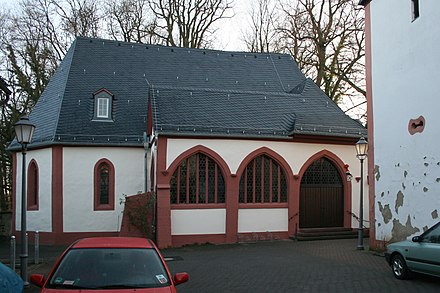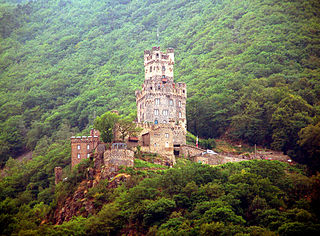
Sooneck Castle is a castle in the upper middle valley of the Rhine, in the Mainz-Bingen district of Rhineland-Palatinate, Germany. It is located near the village of Niederheimbach between Bingen and Bacharach.

Heiligenburg Castle is a castle on the hill of Heiligenberg in the district of Schwalm-Eder-Kreis, Hesse, Germany.

Schloss Heiligenberg is a castle to the east of Jugenheim, part of Seeheim-Jugenheim, about 12 kilometres to the south of Darmstadt, Germany. It is built on the Heiligenberg, with panoramic views of the Rhineland as far as the Palatinate. It is now the headquarters of the Amtes für Lehrerbildung, though its 'Gartensaal' is occasionally used for concerts and art exhibitions.
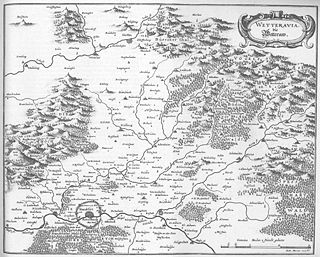
Wetterau Association of Imperial Counts was an association of countly families in the Wetterau and surrounding areas. It originated in the late Middle Ages and was formally disbanded when the Holy Roman Empire was dissolved in 1806.

Herborn Castle is situated right above the city of Herborn, in the Lahn-Dill district of the state of Hesse, Germany.
A Ganerbenburg is a castle occupied and managed by several families or family lines at the same time. These families shared common areas of the castle including the courtyard, well and chapel whilst maintaining their own private living quarters. They occurred primarily in medieval Germany.
A Ganerbschaft, according to old German inheritance law, was a joint family estate, mainly land, over which the co-heirs (Ganerben) only had rights in common. In modern German legal parlance it corresponds to a "community of joint ownership".
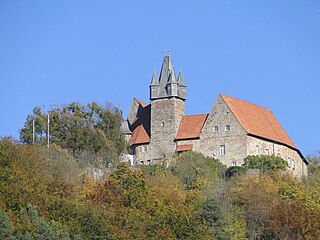
Spangenberg Castle is a schloss above the small German town of Spangenberg in the North Hesse county of Schwalm-Eder-Kreis. The originally Gothic building was first a medieval fortified castle, then a fortress, hunting lodge, prison, forestry school and is now a hotel and restaurant.

Otzberg Castle in the German state of Hesse is a medieval castle on the summit of the Otzberg in the Odenwald forest at a height of 367 m above NN. On its northern slopes is the village of Hering, which grew out of the lower ward or castellan's settlement. The history of castle and village is therefore closely interwoven.

Idstein Castle, later the Renaissance style Schloss Idstein, is located in Idstein in the county of Rheingau-Taunus, Germany. The hill castle was the residenz of Nassau-Idstein. The castle's Witches' Tower (Hexenturm) is one of the town's oldest buildings and a substantial local landmark.

Greifenstein Castle lies in the eponymous village of Greifenstein in the county of Lahn-Dill-Kreis in Middle Hesse, Germany. It is a geo point in the national geopark of Westerwald-Lahn-Taunus.

Falkenstein Castle, also called New Falkenstein (Neu-Falkenstein), is a ruined hill castle at 450 m above sea level (NHN) in the eponymous climatic spa of Falkenstein, a quarter of Königstein im Taunus in the county of Hochtaunuskreis in the German state of Hesse.

The Sababurg, first called the Zappenburg, then Zapfenburg and today, after the Brothers Grimm fairy tale Sleeping Beauty Castle, is the ruin of a hill castle in the legendary Reinhardswald, a forested upland that runs through the North Hessian county of Kassel. Sababurg is also the name of a district of the town of Hofgeismar in which the castle is found.
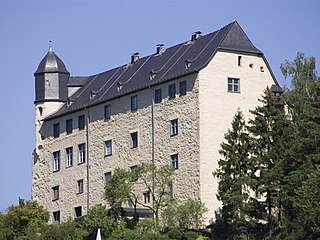
Schadeck Castle is a counter-castle which was built in opposition to the nearby Runkel Castle. It stands above the River Lahn in the eponymous parish in the county of Limburg-Weilburg in the German state of Hesse.

Schloss Holzheim is a former hunting seat of the ruling family of Hesse-Kassel, located in the village of Holzheim in the German state of Hesse, approximately 80 kilometres (50 mi) south of Kassel. The hunting lodge was built between 1732 and 1735 under Frederick I, King of Sweden and also Landgrave of Hesse-Kassel, in baroque style on the medieval foundation walls of the former manor house of the local noble families Von Holzheim and Von Romrod. Frederick's father, Landgrave Charles I, Landgrave of Hesse-Kassel had often come here for hunting. Frederick's brother and governor, Prince William, liked to be here as well because of the rich game population of the forest areas around the princely estate.

Waldmannshausen Castle is a water castle built from 1486 to 1488 by Thebus of Waldmannshausen in the village of Elbgrund in the municipality of Elbtal) in the county of Limburg-Weilburg in the German state of Hesse. It is located about 18 kilometres north of the town of Limburg an der Lahn. The castle was once a single unit with the neighbouring estate of Waldmannshausen. On the land of the estate is another, ruined, water castle, the Alte Burg. The property is on the edge of the municipality on the road to Frickhofen. The castle and its associated schloss, built in 1790, have been used as a Schullandheim - a country educational facility used to enhance normal schools - since 1935. The castle is owned by Schullandheim Burg Waldmannshausen;; with its headquarters in Westphalian Hagen.

Auersburg Castle is a ruined hill castle in parish of Hilders in the county of Fulda in Hesse, Germany. The site is used today as a shelter and viewing platform.
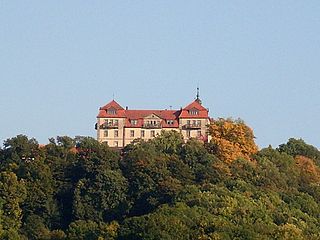
Bieberstein Palace is a baroque palace that was built between 1710 and 1740 by Bamberg architect, Johann Dientzenhofer. It is located in the parish of Hofbieber, which is part of Langenbieber, and about 2 km south of Hofbieber on the hill of the Kugelberg, a southern spur of the Hessenliede. South of the Kugelberg the terrain descends into the valley of the Bieber. The palace is about 16 km east of Fulda, the county town.

Haselstein Castle is a ruined hill castle near the village of Haselstein in Nüsttal in the county of Fulda in Hesse, Germany. It lies next to the village on a steep basalt cone at a height of 434 m above sea level (NN). The rock was first mentioned in 780/781 as the Haselahastein.
